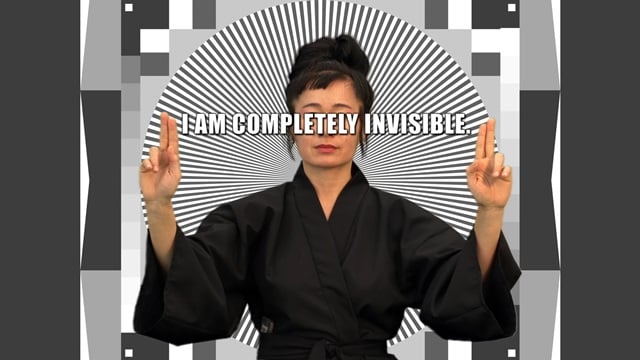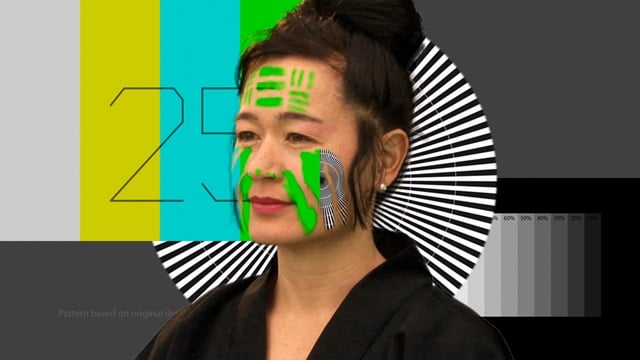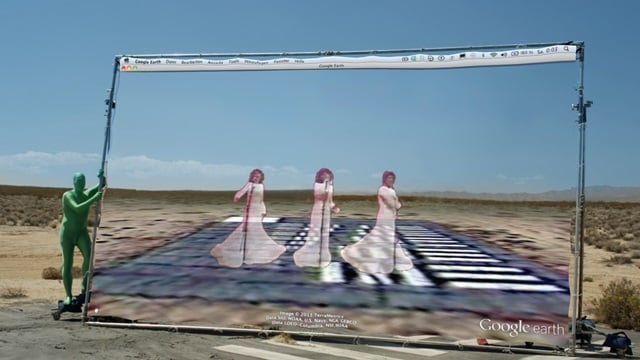Art & Exhibitions
Hito Steyerl’s Video Art Goes in Search of Invisibility
Can somebody ever escape from the overlords of global cyber-control?

Can somebody ever escape from the overlords of global cyber-control?

Christian Viveros-Fauné

Technology giveth and technology taketh away. This has long been the Janus-faced nature of machine and digital advances since way before the explosion of the interwebs. But after the early peace-in-our-time promises of Facebook and hacker culture devolved rapidly into, well, the data mining of Facebook and the surveillance of the NSA, a crucial question has trickled down to certain critical computer mavens: Can one escape from the far-reaching tentacles of digital tracking or, rather, should we fully submit, like modern-day peons, to today’s overlords of global cyber-control?
Hito Steyerl, a Berlin-based artist and filmmaker who is better known as a theorist of digital images, has dedicated her latest exhibition at Chelsea’s Andrew Kreps Gallery to reformulating that question thusly: “How do people disappear in an age of total over-visibility?”
Titled “How Not To Be Seen: A Fucking Didactic Educational Installation,” Steyerl’s exhibition sardonically entertains the idea of escape from the era’s Orwellian regime of digital and actual “visibility.” Like her essay collection “The Wretched of the Screen,” her show proves insightful, but at times glibly clever. For every point struck home about Big Data and the Surveillance State, naïve fantasies of hyperreal subversion pop up like blurry GIFs ripped from the film version of Society of the Spectacle. Anyone for low-res Guy Debord?
An exhibition made up of two videos, several arrangements of white lines painted on the floor, a video viewing box constructed diagonally inside the gallery, and a group of sculptural objects that combine green tiles with photographs of a rugged landscape, Steyerl’s installation—which is mock-didactic to a fault—reminds one of a famous observation by George Bernard Shaw. Technicians and specialists, he said, much like conceptual artists, routinely conspire to protect their special status by making their vocabularies incomprehensible. At Kreps, this willful opacity turns out to be principally visual. Steyerl’s video Strike, for instance, greets the viewer with a knowing one liner—its looping action consisting only of the artist repeatedly hitting a flatscreen with a hammer. Similarly, her tripod-like sculptural objects appear as props in a weightier second video, yet also take up primo gallery space to no apparent purpose. As sculptures, they’re gobbledygook in 3-D.

Hito Steyerl, How Not To Be Seen: A Fucking Didactic Educational .Mov File (2013)
HD video, single screen in architectural environment, 14 minutes.
Photo: Courtesy of the artist and Andrew Kreps Gallery, New York.
Steyerl’s main event, on the other hand, features 14 minutes of mordantly funny, sometimes smug, digital video exposition about how to disappear from the world’s tracking systems through a series of ancient and novel tricks. One can choose, for example, to live inside a gated community, shrink oneself down to the size of a pixel, or simply exist as a woman over the age of 50. Filmed on location in the California desert at a disused US Air Force site, the video How Not To Be Seen: A Fucking Didactic Educational .MOV File pulls together some of Steyerl’s more trenchant theoretical preoccupations with several especially cryptic elements. According to Steyerl, the parallel and perpendicular lines inside the gallery are aerial calibration targets—the granddaddy of digital pixels. The sculpture’s tiles, or at least their color, also repeat in footage of the artist applying bright green paint to her face. When shot against a green screen, her image vanishes out of thin air—like Malaysian Airlines flight 370 over the Indian Ocean.
Relayed in the form of a mock instructional film, Steyerl’s video montage is full of real and computer-generated imagery—including shots of an actual film crew, as well as a virtual shopping mall that unfolds while a tinny computer voice cues many of the artist’s dryly comic vignettes. “Resolution determines visibility,” the voiceover intones, as a camera pulls away from Steyerl’s desert location to take in “the world as a picture”—“Whatever is not captured by resolution is invisible.” Later, following images of the kimono-clad artist enacting examples of how to hide in plain sight, the artist’s computerized deep throat deadpans this nugget with laconic astringency: “Today the most important things want to remain invisible. Love is invisible. War is invisible. Capital is invisible.” Even when irritated by the video’s general smart-alecky tack, this short speech constitutes black humor as an epiphany.

Hito Steyerl, How Not To Be Seen: A Fucking Didactic Educational .Mov File (2013)
HD video, single screen in architectural environment, 14 minutes.
Photo: Courtesy of the artist and Andrew Kreps Gallery, New York.
In view of Steyerl’s considerable critical and satirical gifts, it’s difficult to understand why such a discerning artist prefers to repeat the often fantastical and unexamined clichés of “progressive” hacker culture. Looked at as art-as-theory, Steyerl basically uses her .MOV file to largely illustrate the “emancipatory” possibilities of pixelated images, compressed AVI files, and glitchy live-streaming she championed in her 2009 essay “In Defense of the Poor Image.” Yet the ideas behind Steyerl’s current multimedia installation—despite their frequent illuminations—crucially misjudge not just their wiseacre tone, but the fundamental nature of today’s digital transformations.
Like in the early days of the Jaquard loom, the digital revolution has not exactly uncovered beaucoup beaches beneath the paving stones, but has led instead to globe-girding economic “creative destruction,” vast income inequality, and the ticking time bomb of high-frequency trading. All of which leads this critic to the following thoughts: Technology, along with art that wrongheadedly imbues machine punch cards and degraded digital images with utopian ideals, remains very much a Faustian bargain. Art is rarely about “how not to be seen” but it is always about seeing clearly past blurry basic assumptions.
“How Not To Be Seen: A Fucking Didactic Educational Installation” runs at Andrew Kreps, 537 West 22nd Street, New York, through August 15.